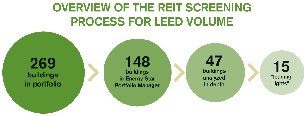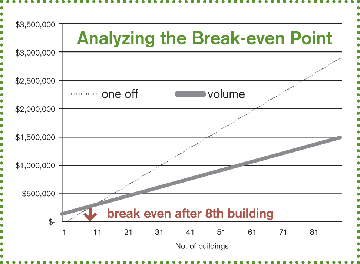How a Commercial Office REIT Used LEED Volume
The following example highlights how a commercial office REIT in the Mid-Atlantic region developed a business case for LEED Volume instead of a one-off strategy for obtaining certification.
Facing increasing demand for green office space from tenants (primarily government contractors), a need to reduce operating costs, and competition for market share from other commercial property owners, this REIT certified a few properties individually using the LEED for Existing Buildings: Operations and Maintenance (LEED-EBOM) rating system. These initial certifications were somewhat painful because each property management team had to feel its way through the certification process each time with inexperienced consultants. In addition, because there was no consistent path to certification, the costs were hard to predict and control.
The REIT's goal was to build on its leadership position in customer service by certifying a significant percentage of the portfolio while optimizing the cost and level of effort required to certify each building. Over a two-month period the portfolio of 269 buildings was screened against metrics including financial criteria, property management team capacity/capability and operational alignment to LEED-EBOM certification. The screening process identified 15 "leading light" buildings that defined high performance property management best practice for the REIT. (See "The REIT Screening Process for LEED Volume" below.)
These "leading light" properties were used to determine a potential LEED Volume precertification approach and to generate estimates of level of effort, building performance improvement costs, certification fees and vendor costs. By calculating the expected returns from operating expense reductions and reduced certification costs (compared to one-off certification costs), a financial analysis of the Volume program break-even point was possible.
In this case, certifying properties through the Volume program was estimated to deliver payback after the eighth certification. Because the REIT was looking to certify at least 25 buildings, a Volume certification approach made financial sense.
— Patrick Leonard
Related Topics:
















